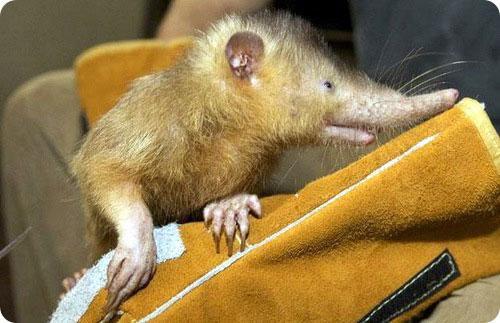1797
Strange and rare animals on our planet
All these animals are real.

SOLENODON. Insectivorous mammal of the order is divided into two main types: the Cuban and Haitian SOLENODON. Relatively large, relative to other types of carnivorous beast: its length is 32 cm, and the tail, on average, 25 cm, weight of the animal - about 1 kilogram, dense physique.

Sifaka. Monkey family indriidae. A relatively new kind of primate, opened only in 2004. Silky Sifaka live in the eastern part of the island of Madagascar. The area is about 2, 2 thousand sq. M. km. Distribution territory is bounded on the north of the core area of Marojejy Massif, and to the south comes to Anjanahari. Adults have a body length with a head of 45 to 55 cm, tail length 45-51 cm. Weight 5-6, 5 kg

Maned wolf. It lives in South America. Long legs of a wolf - the result of the evolution in matters of adaptation to habitat, they help the animal to overcome obstacles in the form of tall grass growing on the plains

African Civet. The only representative of the eponymous family. These animals live in Africa, in open spaces with high herbage from Senegal to Somalia, south to Namibia and eastern areas of South Africa. The size of the beast may be strong enough to visually increase when Viverra raises when excited wool. A fur her thick and long, especially on the back closer to the tail. Paws, muzzle and the tail end of an absolutely black, most of the body pyatnistopolosataya

Desman. Animal quite famous, thanks to its great title. Just picture a good

Varieties of spiny anteaters. This natural wonder is usually weighs up to 10 kg, although marked and more large individuals. Incidentally, the length of the body reaches 77 cm varieties of spiny anteaters, and that's not counting their cute five to seven centimeter tail. Any description of the animal is based on a comparison with a malicious: foot above varieties of spiny anteaters, powerful claws.
Another feature of the appearance of varieties of spiny anteaters - it spurs on their hind legs males and five-fingered hind limbs and three-toed front.

Capybaras. Semi-aquatic mammals, the largest of modern rodents. It is the only member of the family vodosvinkovyh (Hydrochoeridae). There are dwarf varieties Hydrochoerus isthmius, sometimes it is regarded as a separate species (small capybara). The most melancholy and kind creature on Earth.

Sea cucumber (sea cucumbers). Marine Potbelly, sea cucumbers (Holothuroidea), a class of invertebrates such as echinoderms. The species used for food, are collectively called "trepang»

Pangolin. This top could not do without it

Vampire squid. Shellfish. Despite its obvious similarities with octopus and squid, shellfish, scientists have identified this as a separate detachment Vampyromorphida (Lat.), Because as soon as it has its own retractable sensitive bichevidnye filaments

Aardvarks. In Africa, these mammals called aardvark, which translated into Russian means "ground hog". In fact aardvark on appearance it is very much like a pig, but with a long snout. The ears of this amazing animal in its structure is very similar to the bunny. As yet there is also a muscular tail, which is very similar to the tail of an animal like a kangaroo

Japanese giant salamander. Today - the largest amphibian, which can reach 160 cm in length and weight up to 180 kg and can live up to 150 years, though officially registered the maximum age of the giant salamander is 55 years old.

Bearded Pig. In view of the different sources of Bearded Pig is divided into two or three sub-species. It - curly bearded pig (Sus barbatus oi), who lives on the Malay Peninsula and the island of Sumatra, Bornean bearded pig (Sus barbatus barbatus) and Palawan Bearded Pig, who live, as the name implies, on the island of Borneo and Palawan, as well as in Java , Kalimantan and the small islands of the Indonesian archipelago in Southeast Asia


Sumatran Rhinoceros. They belong to the family of equine animals rhinoceros. This kind of rhino is the smallest of the entire family. The body length of an adult Sumatran rhino can reach 200 - 280 cm, and the height at the withers can range from 100 to 150 cm. These rhinos can weigh up to 1,000 kg

Knobbed BEAR couscous. Wood marsupial that lives in the upper tier of the lowland rainforest. Wool bearish couscous consists of a soft undercoat and coarse guard hairs. The color ranges from gray to brown, with a light-colored belly and limbs, and varies depending on the geographic subspecies and age of the animal.
Grasping, not woolly tail is about half the length of the animal, and serves as a fifth limb, which facilitates progress in the dense rainforest. Bear couscous it is the most primitive of all the couscous which keeps the growth of teeth and primitive features of the structure of the skull.

Galaga. His big bushy tail is clearly comparable with the squirrel. A charming attractive face and graceful movement, flexibility and enticing, vividly reflect his cat line. The amazing leaping ability, agility, strength and agility of this incredible animal clearly shows his funny nature and elusive cat proteins.
Of course, it would be where to use their talents, because small cage for this very ill-suited. But if you give it a small animal sometimes a little bit of freedom and let him walk around the apartment, all its quirks and talents will become a reality. Many even compare it with a kangaroo.

Wombat. No photo wombat do not talk about the strange and rare animals
to be continued…

SOLENODON. Insectivorous mammal of the order is divided into two main types: the Cuban and Haitian SOLENODON. Relatively large, relative to other types of carnivorous beast: its length is 32 cm, and the tail, on average, 25 cm, weight of the animal - about 1 kilogram, dense physique.

Sifaka. Monkey family indriidae. A relatively new kind of primate, opened only in 2004. Silky Sifaka live in the eastern part of the island of Madagascar. The area is about 2, 2 thousand sq. M. km. Distribution territory is bounded on the north of the core area of Marojejy Massif, and to the south comes to Anjanahari. Adults have a body length with a head of 45 to 55 cm, tail length 45-51 cm. Weight 5-6, 5 kg

Maned wolf. It lives in South America. Long legs of a wolf - the result of the evolution in matters of adaptation to habitat, they help the animal to overcome obstacles in the form of tall grass growing on the plains

African Civet. The only representative of the eponymous family. These animals live in Africa, in open spaces with high herbage from Senegal to Somalia, south to Namibia and eastern areas of South Africa. The size of the beast may be strong enough to visually increase when Viverra raises when excited wool. A fur her thick and long, especially on the back closer to the tail. Paws, muzzle and the tail end of an absolutely black, most of the body pyatnistopolosataya

Desman. Animal quite famous, thanks to its great title. Just picture a good

Varieties of spiny anteaters. This natural wonder is usually weighs up to 10 kg, although marked and more large individuals. Incidentally, the length of the body reaches 77 cm varieties of spiny anteaters, and that's not counting their cute five to seven centimeter tail. Any description of the animal is based on a comparison with a malicious: foot above varieties of spiny anteaters, powerful claws.
Another feature of the appearance of varieties of spiny anteaters - it spurs on their hind legs males and five-fingered hind limbs and three-toed front.

Capybaras. Semi-aquatic mammals, the largest of modern rodents. It is the only member of the family vodosvinkovyh (Hydrochoeridae). There are dwarf varieties Hydrochoerus isthmius, sometimes it is regarded as a separate species (small capybara). The most melancholy and kind creature on Earth.

Sea cucumber (sea cucumbers). Marine Potbelly, sea cucumbers (Holothuroidea), a class of invertebrates such as echinoderms. The species used for food, are collectively called "trepang»

Pangolin. This top could not do without it

Vampire squid. Shellfish. Despite its obvious similarities with octopus and squid, shellfish, scientists have identified this as a separate detachment Vampyromorphida (Lat.), Because as soon as it has its own retractable sensitive bichevidnye filaments

Aardvarks. In Africa, these mammals called aardvark, which translated into Russian means "ground hog". In fact aardvark on appearance it is very much like a pig, but with a long snout. The ears of this amazing animal in its structure is very similar to the bunny. As yet there is also a muscular tail, which is very similar to the tail of an animal like a kangaroo

Japanese giant salamander. Today - the largest amphibian, which can reach 160 cm in length and weight up to 180 kg and can live up to 150 years, though officially registered the maximum age of the giant salamander is 55 years old.

Bearded Pig. In view of the different sources of Bearded Pig is divided into two or three sub-species. It - curly bearded pig (Sus barbatus oi), who lives on the Malay Peninsula and the island of Sumatra, Bornean bearded pig (Sus barbatus barbatus) and Palawan Bearded Pig, who live, as the name implies, on the island of Borneo and Palawan, as well as in Java , Kalimantan and the small islands of the Indonesian archipelago in Southeast Asia


Sumatran Rhinoceros. They belong to the family of equine animals rhinoceros. This kind of rhino is the smallest of the entire family. The body length of an adult Sumatran rhino can reach 200 - 280 cm, and the height at the withers can range from 100 to 150 cm. These rhinos can weigh up to 1,000 kg

Knobbed BEAR couscous. Wood marsupial that lives in the upper tier of the lowland rainforest. Wool bearish couscous consists of a soft undercoat and coarse guard hairs. The color ranges from gray to brown, with a light-colored belly and limbs, and varies depending on the geographic subspecies and age of the animal.
Grasping, not woolly tail is about half the length of the animal, and serves as a fifth limb, which facilitates progress in the dense rainforest. Bear couscous it is the most primitive of all the couscous which keeps the growth of teeth and primitive features of the structure of the skull.

Galaga. His big bushy tail is clearly comparable with the squirrel. A charming attractive face and graceful movement, flexibility and enticing, vividly reflect his cat line. The amazing leaping ability, agility, strength and agility of this incredible animal clearly shows his funny nature and elusive cat proteins.
Of course, it would be where to use their talents, because small cage for this very ill-suited. But if you give it a small animal sometimes a little bit of freedom and let him walk around the apartment, all its quirks and talents will become a reality. Many even compare it with a kangaroo.

Wombat. No photo wombat do not talk about the strange and rare animals
to be continued…
























